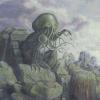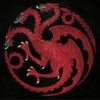1- The Syndicate’s Tattoo Artist states that “After Tattoo Artist is committed to a Story, choose a character…â€
Does this mean that immediately after she is committed to a Story she must choose to use her Response, before the opponent commits characters to Stories. Or is this simply a condition which must first be met before she can use her Response; thus allowing her to target an opposing character afterwards as needed?
Responses detail the condition that must be met for you to trigger its effect, which opens a window for you to play that card. The window closes when the next player or framework action opportunity occurs, so you have to trigger it before then.
For Tattoo Artist, this means immediately after she (along with any other of your participating characters) is committed to a story, which as an attacker means triggering the Response at the end of
5.ii), because when
5.iii) rolls around it's time for Actions which is too late - referring to the Detailed Turn Sequence diagram in the rule book for the Story phase, of:
5.i) Actions may be taken
5.ii) [You (active player commit character to stories)]
5.iii) Actions may be taken
5.iv) [Opponent (non-active player) commits character to oppose yours]
5.vi) Actions may be taken
5.vii) <Resolve stories>
5.viii) [Response to struggle and success results may be played]
5.ix) Actions may be taken
5.x) [Characters are uncommitted from stories]
Note that no Actions can be played in [square]-bracketed steps; and no Actions or Responses can be played in <angle>-bracketed steps; but Disrupts can, and Forced Responses must, be played at the moment indicated on the card.
You'll note that the
5.vii) <Resolve stories> step, where most of the action happens (e.g. characters going insane from losing Terror, or taking a wound from losing Combat), does not permit Responses (or Actions) to be played at this time. For cards like Military Advisor (
Response: After Military Advisor is wounded, pay 2 to choose and wound a character with skill lower than Military Advisor.), if he loses Combat and takes a wound what happens is that a window has opened for his Response. He can't trigger it at that moment, because no Responses are allowed, but the window for his Response and any other similar cards carries over to step
5.viii) [Response to struggle and success results may be played] after all the stories are resolved. The Responses window closes at the next player or framework action opportunity arises, which for struggle/story-related is with step
5.ix) Actions may be taken.
One last note about Responses is that they happen after the described occurrence, whereas Disrupts have the ability to insert themselves before, during or after the occurrence as described on the card. For Military Advisor, this means if the wound he had taken was fatal (e.g. he'd exceeded his Toughness +2 in taking a third wound), he would die from the wound before he could trigger his Response. Whereas Forest Sister (
Disrupt: Pay 1 to cancel a wound to Forest Sister.) could use her Disrupt ability to prevent being destroyed from a wound she was about to receive.
2- Temporal Slip states “Disrupt: After an Icon struggle effect resolves, choose an Icon struggle. Resolve that struggle as if you had won itâ€.
I was using this to counter my husband’s Hastur Character’s Terror struggle. Re-reading we’re not sure if this actually skips the struggle and lets me win it or instead the struggle would still happen; he would win it and apply its effects, and then I would get to choose any Icon struggle at that Story and resolve its effects as if I had won it?
"choose an Icon struggle. Resolve that struggle as if you had won it" means that you can choose any icon struggle effect to occur in your favour; inserted as an additional struggle that you automatically win, and not as a replacement.
"After an icon struggle effect resolves" means after one struggle has fully completed, including any consequences (e.g. after a Terror struggle has occurred and, if there was a loser with a susceptible character, one character has gone insane as a result), and before the next struggle begins. (Note that this is different to the timing described by WasteMaLife.)
Here is the general wording guide for struggle timing, taken from the three-part conversation
here --
*
Before a struggle resolves - this must be triggered after whatever the last player or framework action ends but before the struggle event begins.
*
When a struggle resolves - this must be triggered when the struggle begins, after the previous player or framework action but before any calculation is made.
*
When you would win/lose a struggle - this must be triggered when the winner/loser is determined, after the icon calculations are made but before the effect of the struggle is applied.
*
After you lose/win a struggle - this must be triggered after the result of the struggle has resolved, after calculations, but before moving to the next framework action.
I take Temporal Slip's "After an icon struggle effect resolves" to be a variant of 'After you lose/win a struggle'.





 Sign In
Sign In Create Account
Create Account




 Back to top
Back to top
















